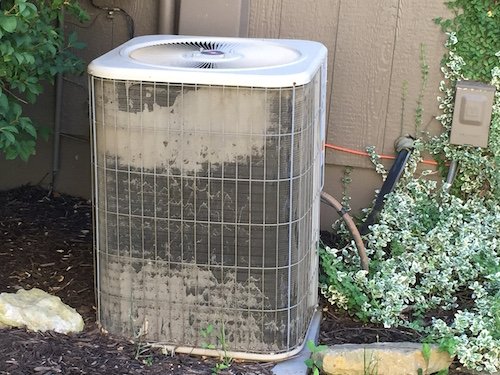Helpful Tips When Your AC Is on Life Support

The older your air conditioner gets, the more likely it is to break down. It’s just a fact of life. So if you’re limping along with an older AC hoping it will make it through one more season, the team at Lancaster Brothers has gathered some AC troubleshooting tips just for you.
AC Troubleshooting Tips
The two main problems people encounter with air conditioners are:
- It won’t turn on
- It runs, but won’t cool
The following troubleshooting tips can help you beat the heat and get back to enjoying cool air in your home.
Your AC Won’t Turn On
If your AC is not kicking on, you have several things to check:
Thermostat – check your thermostat to make sure that it isn’t set to the heat or off position. Also check to make sure that the batteries in your thermostat are not dead. (You’d be surprised how many service calls we answer and the problem is one of these two things.)
Tripped Breaker – check your electrical panel to make sure that the breaker connected to your AC hasn’t been tripped.
Power Switch – look to see if the power switch on the side of your furnace is turned on. (Yes, there’s a power switch on the side of your furnace.)
The AC Is On, but the Air Isn’t Cool
Dirty Air Filter – One of the biggest issues that will cause this problem is a dirty air filter. Check your filter to see how dirty it is and replace it if necessary. Remember, it is important to change your filter once a month to ensure proper airflow and cooling.
Ice Accumulation – Ice in the outdoor unit can also cause your AC to run sluggishly. If you see ice you should turn off the AC and allow it to thaw for a couple of hours.
Clogged Condensate Drain – If you are still having trouble, consider cleaning out the condensate drain. Algae tends to build up in these pipes and will cause your AC to fail.
Check Your Condenser Unit Outside
Don’t forget your air conditioner has another piece – outside. The condenser unit outside can sometimes be the problem. Look for these three problems:
A safety precaution first – The condenser is a 240-volt box and we don’t want anyone getting hurt, so turn off the power to it at the electrical panel before working on it. Also turn off the disconnect box located outside, near your unit. It will either be a lever, fuses, or a circuit breaker to shut off the condenser. Then, allow about 30 minutes for the electrical charge that’s stored in the condenser’s capacitor to dissipate. Okay, now it’s safe to check the unit. We recommend letting one of our qualified technicians look over these items.
Clear Debris – Make sure the unit is clean and clear of debris. Clear away dirt, leaves, etc. Check the fan to make sure it is clear of debris as well.
Clogged Drain – Check the drain and make sure it is clear.
Broken Coolant Lines – Check the coolant lines (pipes that connect the condenser unit outside to the evaporator on the inside unit). They can get bumped around being outside.
Turn the unit back on. First, turn the thermostat in your home to OFF. Then turn on the power at both the disconnect box and at the main panel. Last, switch the thermostat to COOL. Give it some time and see if you feel cool air blowing from the ducts. You can also check your outdoor unit to see if the air blowing out the top is warmer than the surrounding air.
A Formula to Know How Many AC Repairs Are Too Many
So you know your AC is on its last leg, but how do you know when it makes the most sense to replace it instead of throwing good money after bad? First, look for these four warning signs:
- Your unit is 10-12 years old
- You’ve paid for three or more repairs over the last two years
- Your energy bills seem excessive
- You are experiencing uneven cooling or certain rooms feel uncomfortable
NOTE: Sometimes hot spots can be due to poor ductwork. We can inspect your ducts and make adjustments if that is the case.
These are all clues that it is getting close to the time to replace your unit. Luckily, there’s a formula you can use to help you decide. We call it the $5,000 rule.
The $5,000 Rule
Multiply the age of your AC unit by the repair cost, and if that exceeds $5,000, then replace the unit. If it’s less, go ahead and repair it.
Here is an example, if your unit is 10 years old and the repair will cost $350, multiply 10 x 350 to equal $3,500. It is less than $5,000, so it’s okay to have it repaired.
Consider the Rising Cost of Freon
With the rising cost of Freon (coolant used in most older systems), if your repair involves adding Freon because of a leak, you have something else to consider. If you have a Freon leak, you will have to add more every year and the price of Freon is rising each year. The reason is because about 25 years ago, the EPA ordered the phasing out of Freon as part of an international treaty focused on protecting the ozone layer. Production ended in 2010 for new air conditioning units. Production has also been reduced in subsequent years. By 2020, production of Freon will end, so the price will only continue to rise.
Let Lancaster Help with Repairs or Replacement
 If your AC has several of the symptoms we listed, we will be happy to take a look and either repair or replace the unit so you and your family stay cool and comfortable. Lancaster Brothers is proud to install Lennox air conditioners, so if your air conditioner is on its last leg we will be happy to provide a free estimate. There are also rebates and financing available for qualifying systems, and our comfort specialist will tell you about all of the available specials.
If your AC has several of the symptoms we listed, we will be happy to take a look and either repair or replace the unit so you and your family stay cool and comfortable. Lancaster Brothers is proud to install Lennox air conditioners, so if your air conditioner is on its last leg we will be happy to provide a free estimate. There are also rebates and financing available for qualifying systems, and our comfort specialist will tell you about all of the available specials.
